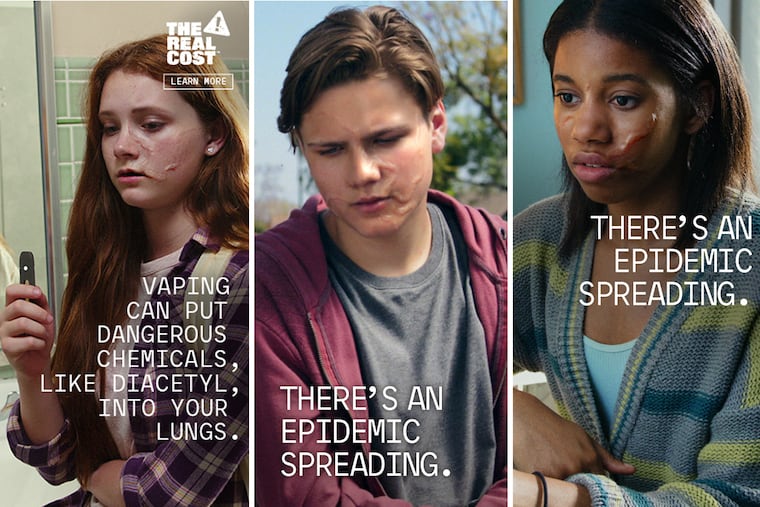FDA shows ‘real cost’ of vaping with new ad campaign
The ad campaign is aimed at 10.7 million kids ages 12 to 17, who have used or are willing to try e-cigarettes.

The videos show parasite-like creatures tunneling across blemish-free faces, under scalps and into the lungs of unsuspecting teens. A still image shows a teen's mouth replaced with a USB-like port.
They are meant to be shocking — albeit in a science-fiction way.
The images are part of the U.S. Food and Drug Administration's $60 million anti-vaping ad campaign, called "The Real Cost." The campaign is aimed at the 10.7 million kids. ages 12 to 17, who have used or are willing to try e-cigarettes.
A major anti-smoking campaign, "Tips From Former Smokers," uses graphic images, too — of what has happened to people as a result of smoking, such as losing a jaw to cancer.
Vaping hasn't left that kind of highly visible damage — and the practice does not lead users to contract parasites. But the FDA says vaping does put kids at risk of addiction and other serious health problems, and the startling images draw attention to those words.
Nicotine, a compound in the vaping products, can rewire the developing adolescent brain to crave more of the product. The ads also show that e-cigarettes can contain dangerous chemicals such as acrolein, which can cause irreversible lung damage; formaldehyde, a carcinogen; and toxic metal particles, like chromium, lead and nickel, which can be inhaled into the lungs, the FDA stated.
"E-cigarettes have become the most ubiquitous — and dangerous — trend among youth that we believe has reached epidemic proportions," said FDA Commissioner Scott Gottlieb. The presence of fruit and candy flavors is one component that makes the product more attractive to kids, he said.
The agency plans to run the ads where kids will see them — online and in about 10,000 high school bathrooms nationwide. The ads will be on YouTube, Spotify, Pandora, Facebook, and Instagram as well as the FDA's own website.
"No youth should be using any nicotine-containing product," said Gottlieb.
To get an adolescent's attention and make the message resonate, graphics need to be provocative, said Janet Audrain-McGovern, an associate professor in the department of psychiatry at the Perelman School of Medicine of the University of Pennsylvania.
The graphic ads are trying to make the link between the products, the chemicals in the e-cigarettes, and the adverse health conditions they can cause, said Audrain-McGovern. When it comes to nicotine, the content of the ads is accurate based on current research, she said.
"Nicotine hijacks your body," she said. The compound is known to change the brain and increase the risks subsequent substances the teens try will be more pleasurable. It also has an effect on executive function, Audrain-McGovern said.
The ad campaign is the latest effort by the agency to halt the use of e-cigarettes.
Last week it issued a demand that manufacturers provide plans within 60 days showing how they will keep their products out of the hands of minors. The five top-selling national brands — Vuse, Blu, Juul, MarkTen XL, and Logic – make up 97 percent of the U.S. market for e-cigarettes.
This summer, the FDA issued 1,300 warning letters and fines to retailers— both traditional and online — that illegally sold the nicotine-delivering gadgets to minors.
In 2017, more than 2 million middle and high school students were found to have been using e-cigarettes, according to a National Youth Tobacco Survey.
The U.S. Centers for Disease Control and Prevention found that nearly one in 11 U.S. middle and high school students in 2016 reported using cannabis while vaping. That translates to about 2 million youths. The study was published Monday in the journal JAMA Pediatrics.